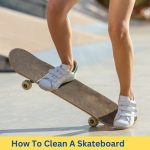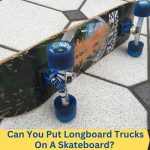As a skateboarder or longboarder, a common issue that you may face is a sudden screeching halt while turning or landing a trick. It is not a technical issue and can be extremely dangerous in some cases – it’s called a Wheelbite!
Contents
What Is Wheelbite?
Wheelbite occurs when your skateboard wheel touches the bottom of your deck while you are riding. The wheels suddenly stop moving, which results in a sudden jolt, losing control of your board and you may even face a nasty fall.
It’s an uncomfortable and sometimes dangerous situation to be in, especially when skating at high speeds. Before learning to prevent it, let’s understand the causes of wheel bite.
Causes of Wheel Bite
Wheelbite occurs due to several factors, including;
- Incorrectly mounted trucks
- Wrong sized or loose trucks
- Not properly locking the trucks
- Smaller wheels on a large board
- Large wheels on a small board
- Worn-down bearings
When wheelbite happens, it can be difficult to complete a trick or stop safely, and cause damage to your board or injury to yourself.
Now that we know the causes of wheel bite, let’s explore the ways to prevent it for a smooth ride.
How to Test for a Wheelbite?
As we know there is no standard space between the deck and wheels, it’s better to test your ride for wheelbite before beginning any skateboarding session, as it can be extremely dangerous.
To do this, I simply push down on the nose and tail of my skateboard to check for any contact with the wheels. I also push and lean the deck left and right. Any contact between the deck and the wheel is an indication that I may face a wheel bite issue while riding. You can also try this method, it’s quite easy and less time taking.
If the deck does not touch the wheels by the above method, now it’s time to check how much clearance you have between the wheel and deck while riding. To do this, roll your skateboard down a slight incline and gently turn to check for wheel bite.
If your wheels stop when turning, then it’s time to make some adjustments.
How To Prevent Wheelbite When Skateboarding?
Now that you know the causes and how to test for wheel bite, let’s explore a few ways to prevent it;
1. Tighten your skateboard trucks
2. Replace the bushings
3. Add riser pads
4. Downsize the wheels
5. Get a deck with wheel wells (or DIY)
6. Apply wax under the wheels
Let’s take a deep look at every solution and how it helps with wheel bite:
1. Tighten Your Skateboard Trucks
It’s a fact that loose trucks usually cause wheel bite, and tightening your trucks is the easiest way to prevent wheelbite.
To do so, make sure that the kingpin nuts are tightened correctly to avoid loose trucks. This will ensure that your board won’t shift or move around during turns and tricks, allowing you to ride smoothly.
Remember not to overdo and tighten the trucks too much, it will damage the bushing and affect the turning radius of your board.
A downside of tightening trucks is that it will make trucks less responsive and you’ll feel them stiff while turning, but it’ll be well worth it if you prefer to ride without wheelbite.
Read tested reviews of the best skateboard trucks.
2. Replace the Bushings
If your trucks are completely tightened but you are still experiencing wheelbite, try replacing the bushings.
Swap your bushings with harder ones if your trucks are too loose, it will reduce how much trucks lean and increase stability to prevent wheel bite.
Here’s the recommended tightness of trucks according to the bushing’s hardness level:
| Bushing Hardness | Truck Feel | Best For |
| Soft Bushings (80a – 90a) | Loose Trucks | Lightweight Skateboarders |
| Medium Bushings (90a – 96a) | Medium Tight | Street, Bowl, Skateparks |
| Hard Bushings (96a+) | Very Tight | Heavy Riders, Landing High Jump Tricks |
3. Add Riser Pads
Riser pads are a great way to prevent wheelbite. They are usually made of rubber or plastic and act as spacers between the wheels and deck, providing extra space for your wheels to turn without touching the bottom of the board.
These pads come in various sizes and thicknesses, so make sure to get one that is right for your set up and provides enough clearance between the wheels and deck.
Riser pads also help to dampen shock, making your ride more comfortable.
There are three sizes of riser pads; 1/8″, 1/4″, and 1/2″, and each one of them increases the height of the board based on its thickness. Depending on the size of your wheels and trucks, you should be able to find one that works best for you.
4. Downsize the Wheels
If your wheels are too big for the deck, then it will cause wheelbite. To prevent this, you should use smaller wheels that match the size of your deck.
Smaller wheels will also help improve your turning radius and give you more control over your board.
5. Get a Deck With Wheel Wells (or DIY)
Wheel wells are cutouts in the deck at the nose and tail that provide extra clearance for the wheels, allowing decks to lower down while preventing wheel bite from occurring.
This is a great way to prevent wheelbite, as it can be done without making any adjustments to your trucks or wheels.
If you have an old deck that doesn’t have wheel wells, then you can easily DIY them with the help of some tools.
6. Apply Wax Under the Wheels
If you do not want to do any changes in the setup or are not willing to do any hassle to fix wheelbite, just apply a little wax at the bottom of the deck under your wheels if they are making minor contact while testing. It will help to prevent wheelbite by creating a slippery surface that reduces friction between the wheels and the deck.
However, this technique will not prevent wheelbite if the contact is severe.
What Should I Do If My Skateboard Experiences Wheel Bite?
If your skateboard has already experienced some degree of wheel bite, then there are a few steps you should take right away in order to minimize any further damage caused by it:
1. Make sure that all bolts on your trucks are adequately tight so that they don’t loosen up while riding.
2. Check if any of your bearings need replacing due to excessive wear.
3. Consider investing in a new set of trucks that have better bushings than what currently came with yours, allowing for smoother turns without fear of damaging them again due to excessive friction against its decking material.
Is It Common To Have Wheelbite On a Skateboard?
Wheelbite can happen to both experienced and inexperienced skaters alike. It is especially common for those who are just starting out, as they lack the knowledge of how to properly setup their skateboard in order to prevent it from occurring.
However, with the right guidance and precautions, wheel bite can be avoided. By following the tips mentioned above, you can ensure that your skateboard will be kept free of wheel bite and remain in top condition.
The most common cause is using larger wheels on a normal size board. For example, if your skateboard is designed to install 52mm wheels and you replace them with 56mm, it will most likely result in wheelbite. So, it’s important to always choose the right sized wheels for your board.
Good skateboard brands test their boards before bringing them to the market, they also test for the wheel bite. So, we recommend investing in a pre-assembled complete skateboard to avoid any unpleasant incidents.
In What Situations Does Wheel bite Happens Most Often?
Getting a wheelbite is inevitable usually, but some riders’ experience is less than others. It mostly depends on your overall skateboard setup and situation.
Let’s dive into skateboarding situations and find out when wheelbite is most likely to happen:
1. Landing From A High Place
When you land from a high place, the impact will cause your wheels to dig into the deck. This could cause wheel bite if it is not properly setup.
According to Physics, a falling object from a height will weigh more, and the weight will vary depending on how tall the rider is. A taller rider will weigh more than a shorter rider, and the impact will be greater.
To avoid wheel bite while landing, learn how to land a jump properly. Place your feet in the middle of the trucks and not at the center of the deck, and keep the board moving as you land instead of keeping it static.
2. Making Sharp Turns
You are most likely to experience wheelbite while making sharp when riding a relatively larger board. This is because the angle of the turn is higher, and the inside wheel will have more contact with the deck.
To help reduce wheelbite during sharp turns, use softer bushings and wider trucks. You can also use riser pads or make wheel wells, whatever suits you better.
3. Rotational Tricks
Rotational tricks like kickflips, heelflips and shuvits require a lot of rotation. Sometimes we press against the deck too much to balance ourselves while landing a trick, which could cause wheelbite if the setup is not correct.
To prevent this, make sure that you do not rotate or lean the board towards one side before landing completely.
Wrapping Up
Wheelbite is an issue that every skater should be aware of in order to ensure their safety on the board. It is one of those pesky problems that can really put a damper on even beginner skaters’ attempts at getting out onto their boards and hitting their favorite spots around town safely and confidently.
To prevent wheelbite from occurring, check all parts of your skateboard regularly for wear and tear, replace old bearings as needed, adjust trucks correctly, use harder wheels for more control when turning/grinding/sliding and make sure risers are installed properly so that wheels don’t touch the deck.
Now that we know what causes it and how we can prevent it (or fix it!), we can get back out there with peace of mind knowing our rides won’t be cut short by unfortunate accidents caused by this issue again!
Frequently Asked Questions
How do you stop a wheel bite?
The best way to stop a wheel bite is by properly setting up your skateboard. Make sure that all the parts of your board are correctly sized and working properly, such as the bearings, trucks and wheels.
What does wheel bite look like?
Wheel bite looks like the wheels grinding against the deck of the skateboard. This can cause them to become warped or even crumbled up, which can result in a total loss of control. It is usually accompanied by a loud grinding noise.
Is wheel bite common?
Yes, wheel bite is a common issue for all types of skateboarders, from beginners to professionals, and in all types of skateboarding. Therefore, it is important to learn how to properly maintain your skateboard in order to prevent wheel bite.
Why do I get wheelbite?
Wheelbite is usually caused by improper setup, such as having too soft bushings or not enough space between the wheels and the deck. It can also be caused by the rider’s weight or improper landing technique.
- Best Electric Skateboard for Big Guys (Heavy Duty E-Boards) - June 3, 2023
- Skateboard Clothing Brands to Make You Stand Out In 2026 - May 31, 2023
- 90s Skateboarding Brands: The Rise and Fall of the Legends - May 28, 2023


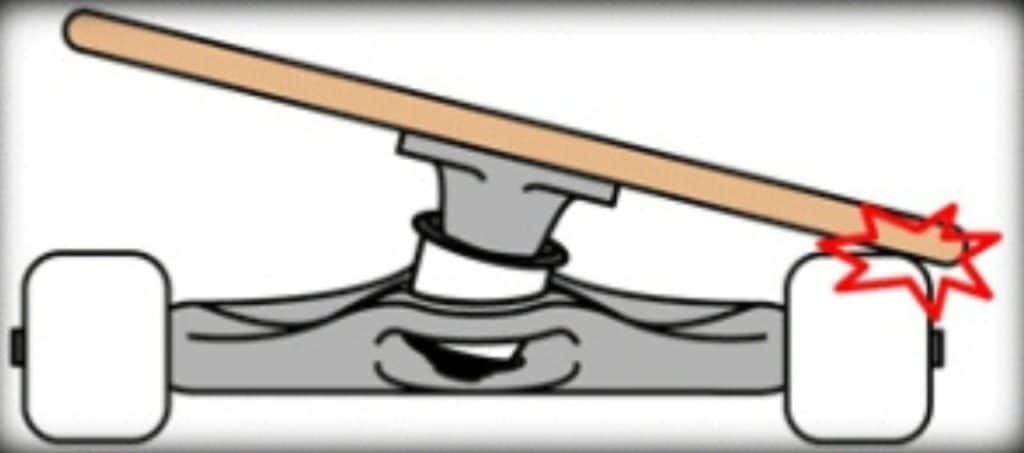
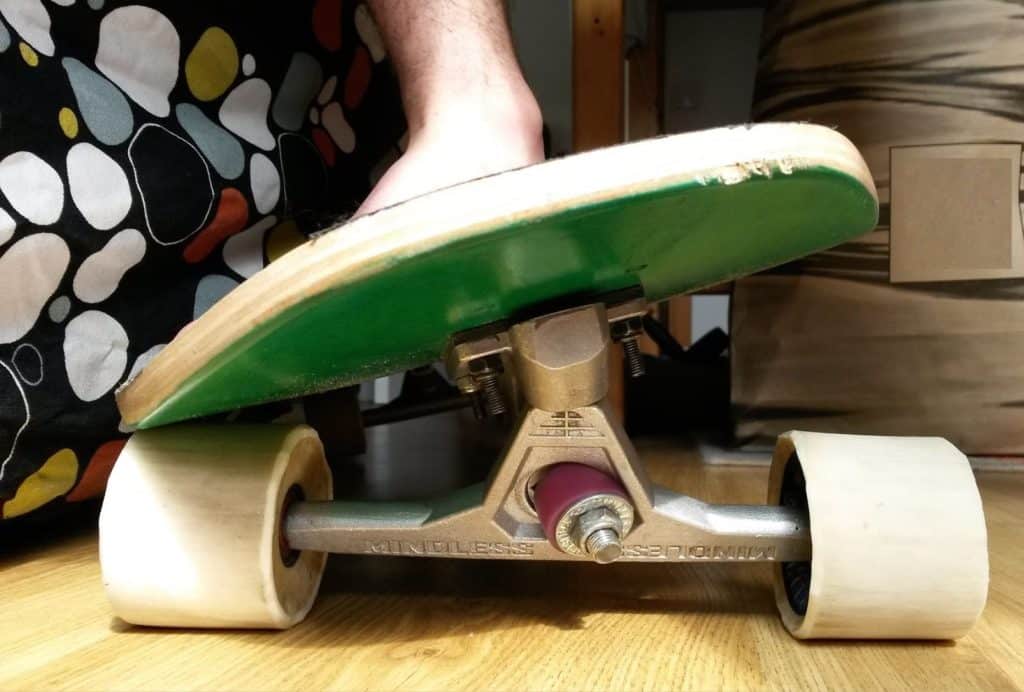
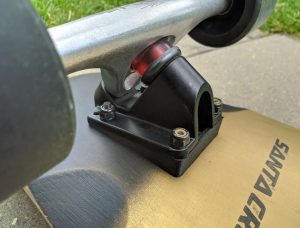

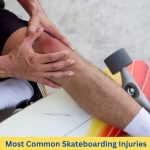
![CCS Skateboard Reviews - [Why They Are Trusted & Popular] ccs skateboard reviews](https://skateboardgeek.com/wp-content/uploads/2023/05/ccs-skateboard-review-150x150.jpg)
![How to Take Trucks off a Skateboard Like a Pro? [The Right Way] how to take trucks off a skateboard without a skate tool](https://skateboardgeek.com/wp-content/uploads/2023/05/how-to-take-trucks-off-a-skateboard-without-a-skate-tool-150x150.jpg)

